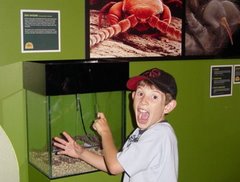Been thinking a bit about this recently after Elaine Gurian sent me something to read, and as we have just completed our corporate planning cycle. Now, I do need to confess that I've become even more addicted to Gordon Ramsay and thinking about his approach to change management (knowing that I've now probably alienated half my readership – sorry 'bout that!) and I think there are many lessons for organisational change buried among the F words! Here's some of my thoughts.
It's about the customer – I lamented in the provocative paper at the Museum Australia Futures Forum about the lack of attention to the needs of visitors, particularly to the physical and showed examples of photographs taken by Benjamin Gilman in 1916 and of visitors to museums in 2006! Our users/stakeholders/visitors (whoever they may be and wherever they are) need to be at our core. Although this is in no way a new idea I believe we still constantly need to be reminded of it.
Get out there and sell yourself to your local constituents – after all, they're the ones with the potential to be your most loyal customers and your best advocates.
Be passionate about what you do – many examples I've seen in Ramsay's shows where he really does force both owners and staff to question their passion and commitment. I remember one study we did back in around 1998 where we found that staff on project teams who were most passionate about what they were doing, engaged and interested produced exhibitions that had better learning outcomes for visitors. Something for us all to ponder on I think.
Taste your food constantly and eat in your own restaurant – how many times do we get out on the floor and taste our products? How many times do we go to our websites and other online content areas and see what people are doing and how they feel about it?
Keep it simple – Ramsay attempts to overhaul menus using a clever combination of simple, seasonal ingredients that make sense within that particular location. From my doctoral work I found that visitors wanted to get both simple and interesting facts they can tell others at a dinner party and/or a deeply moving experience that changes the way they see themselves and their world. Keping a focus on the museum's strengths in terms of content, collections and knowledge - sticking to the knitting - is the competitive advantage we have.
Have high standards for back-of-house – we all want to eat in a restaurant with a clean kitchen, but how much do we really notice what's going on in our public spaces (both physical and virtual)? I'm not only thinking about physical issues here, but high standards in things like data management, collection processes and database systems. This was one of the key lessons I took from this year's Museums and the Web conference especially in relation to online collection access and sharing across our institutions.
Be bold and take risks – how many times does Ramsey challenge the staff (especially the younger and less experienced ones I noticed) to take a risk and try something different? The key point for us in museums is to take risks and be prepared to fail sometimes and be pleasantly surprised at other times. Our work around controversial and challenging topics has shown that visitors want museums to be more challenging and provocative, and can be very forgiving too.
Just as Mal Booth drew on lessons from chamber orchestras in his provocative paper at the Futures Forum and what that means for digitisation in museums, a deeper lesson from that example I think is about creating harmony – bringing all the ingredients (or players) together to share a common purpose. As Elaine reminds us it was Stephen Weil in 1999 who talked about museums not "being about something but being for someone".
There are further ideas about organisational change and museums in relation to implementing Web 2.0 from a paper called Museum 3.0: organisational change and social media I gave at the Social Media and Cultural Communication Conference held in February this year for those that may be vaguely interested.



No comments:
Post a Comment